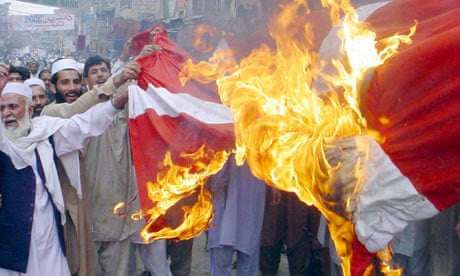Yale University Press has decided against reprinting the Danish cartoons of the prophet Muhammad in a book examining the controversy, after being advised by Islam and counterterrorism experts that doing so could incite violence.
As well as leaving out the 12 cartoons which provoked riots across the Islamic world in 2006, Yale also bowed to recommendations not to include any other illustrations of Muhammad, including a 19th century sketch by Gustave Doré of Muhammad in Hell from Dante's Inferno, in the book, The Cartoons That Shook the World.
Author Jytte Klausen said the book had been ready to go to print when the illustrations were pulled, after Yale received some "quite alarmist" statements from experts who had been sent copies of the proposed images. A professor of politics at a Massachusetts university, Klausen argued for inclusion of the cartoons in the book, which is due out in November in the US and January in the UK. "People think they know the cartoons and actually, by printing the cartoons, I'm arguing that some of them are Islamophobic, and in the tradition of anti-Semitism. If we can't look at them, how can we discuss this?" she said today.
She eventually consented – "reluctantly" – to removing them (she "didn't think it was necessary") but "argued every step along the way" against the excision of the other illustrations: the Doré sketch, an Ottoman print showing the Prophet with a veil over his face, and a reproduction of the cover of a Danish children's book depicting Muhammad.
"You can walk up and down the high street in the UK and pick [the Doré sketch] out of antique bins. The ubiquity of this illustration moved me to want to include it," she said. Admitting that it is "quite explicit" – it illustrates the Inferno canto which shows Muhammad with his entrails hanging out – she proposed substitutions: the same scene has been painted by Rodin, Blake and Dali, but these were not accepted.
"Sadness, not anger, characterises my feelings," said Klausen. "The cartoons ... one can discuss. The removal of the other illustrations poses problems for the text, which was written to the illustrations. I cannot yet judge how confusing it will be to the reader to follow my argument without the illustrations, but for sure these illustrations were intended to awake the reader to the history of depiction of Muhammad in Ottoman, Persian, and Western art - and to show also how we live with images and do not examine them. Well, they will not be examined this time."
Yale said in a statement that "as an institution deeply committed to free expression", it was initially inclined to publish the cartoons and other images as proposed. However, after considering the fact that republication of the cartoons had "repeatedly resulted in violent incidents, including as recently as 2008", it decided to "consult extensively with experts in the intelligence, national security, law enforcement, and diplomatic fields, as well as leading scholars in Islamic studies and Middle East studies".
"All confirmed that the republication of the cartoons by the Yale University Press ran a serious risk of instigating violence, and nearly all advised that publishing other illustrations of the Prophet Muhammad in the context of this book about the Danish cartoon controversy raised similar risk," the statement said. Yale added that it recognised that Klausen's consent was "with reservations", and that "inclusion of the cartoons would complement the book's text with a convenient visual reference for the reader, who otherwise would have to consult the internet to view the images".
But Sheila Blair, professor of Islamic and Asian art at Norma Jean Calderwood University and one of the authorities consulted by Yale about publication, said she had "strongly urged" the press to publish the images. "To deny that such images were made is to distort the historical record and to bow to the biased view of some modern zealots who would deny that others at other times and places perceived and illustrated Muhammad in different ways," she wrote in a letter to the New York Times which is yet to be published.
The president of the American Association of University Professors, Cary Nelson, said in an open letter that the organisation's members "deplore this decision and its potential consequences". "They are not responding to protests against the book; they and a number of their consultants are anticipating them and making or recommending concessions beforehand ... What is to stop publishers from suppressing an author's words if it appears they may offend religious fundamentalists or groups threatening violence?" Nelson wrote." 'We do not negotiate with terrorists. We just accede to their anticipated demands.' That is effectively the new policy position at Yale University Press.".
Klausen has interviewed Middle East politicians, European Muslim leaders, the Danish editors and cartoonists and the Danish imam who kicked off the controversy for the book, which Yale described as "the first comprehensive investigation of the conflict". She argues that the Muslim reaction to the Danish cartoons - which included one
depiction of Muhammad with a bomb in his turban – was not a spontaneous emotional reaction, rather that it was orchestrated, "first by those with vested interests in elections in Denmark and Egypt, and later by Islamic extremists seeking to destabilise governments in Pakistan, Lebanon, Libya, and Nigeria". "Klausen shows how the cartoon crisis was, therefore, ultimately a political conflict rather than a colossal cultural misunderstanding," said Yale of the book.
